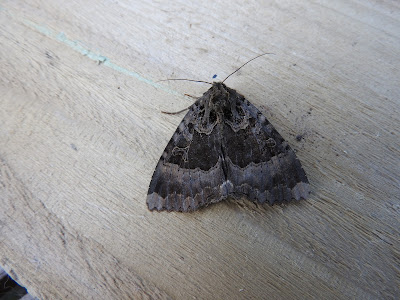Hot, dry and sunny, E2 - The heat continues to build as a high pressure system delivers settled weather over our corner of England with the thermometer nudging 30C this afternoon; ideal then for a high tide swim in Lade Bay along with parties of screeching Sandwich Terns fishing for sprats, piping Oystercatchers flying to roost, Sanderlings scurrying along the tideline and 20 Mediterranean Gulls loafing on the last of the sands.
Whinchat, Trapping AreaWe`ve been out early mornings this week walking the local farmland with Ted before it gets too hot and seeing not a great deal on the migrant bird front apart from a few Willow Warblers, Blackcaps and Common Whitethroats in the hedgerows and two Wheatears and a Whinchat on the fringes of a recently cut hayfield. One or two Yellow Wagtails have passed overhead along with small numbers of Swallows and House Martins, plus 50 Mediterranean Gulls on a turf field yesterday. The purple flowered, nectar-rich Phacelia crop along Ashford Road made a welcome splash of colour and was full of bees, butterflies and other flying insects; infact, some of the larger bees had obviously roosted over night on the spikey flower heads and were still lethargic. Phacelia is a bio-mass plant that is used in conjunction with turf fields as a green manure being ploughed in to improve the soil quality. Also of note today a `kettle` of six Common Buzzards and two Sparrowhawks over New Romney around noon. The garden moth trap continues to be busy with `ridiculous` numbers of Box-tree Moths and another Old Lady.
Phacelia cover crop`Roosting` bee on Phacelia flower
Old Lady
On Monday we visited the local patch where the summer plum Black-necked Grebe was still present on south lake, though diving regularly, plus four Whinchats and two Wheatears on the Desert, several Lesser Whitethroats and a Spotted Fly by the ponds and a Whimbrel over north lake. Dungeness was very quiet with just a couple of Whinchats at the southern end of the Trapping Area and another Spot Flit at the top end of the Long Pits; poor fare then for early September with an easterly airflow, but not unexpected. Elsewhere around the bird reserve there has been little change so far this week and while the usual common passage waders come and go on ARC we`ve yet to record a juvenile Little Stint or Curlew Sandpiper so far this autumn.





No comments:
Post a Comment